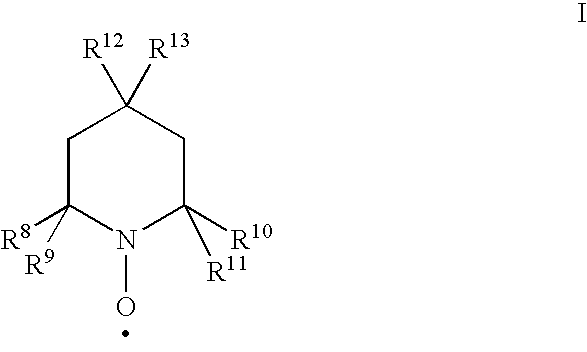Process for preparing alkynecarboxylic acids by oxidation of alkyne alcohols
a technology of alkyne alcohol and alkynecarboxylic acid, which is applied in the preparation of carboxylic compounds, organic chemistry, chemistry apparatus and processes, etc., can solve the problems of high capital cost, contamination of electrolytes with lead ions, and inability to achieve high-capacity production,
- Summary
- Abstract
- Description
- Claims
- Application Information
AI Technical Summary
Benefits of technology
Problems solved by technology
Method used
Image
Examples
example 1
Oxidation of 2-propyn-1-ol to Propiolic Acid in a Biphasic System and in the Presence of Phase Transfer Catalyst
[0146]19.6 g (350 mmol) of 2-propyn-1-ol are dissolved together with 3.0 g (17.4 mmol) of 4-hydroxy-TEMPO in 20 g of CH2Cl2 (reaction component 1).
[0147]14.0 g (350 mmol) of NaOH are dissolved in 436 g of 2.4 M (approx. 357 ml, 857 mmol) of sodium hypochlorite solution (technical bleaching liquor; pH 14) and cooled to 5° C. (reaction component 2).
[0148]In a flask equipped with mechanical stirrer, 5.9 g (17.4 mmol) of tetrabutylammonium hydrogensulfate are initially charged in 132 ml of water and 132 ml of CH2Cl2, and cooled to 5° C. Reaction component 1 and 2 are added in parallel with good stirring and cooling in such a way that the internal temperature does not rise above 10° C. During this time, the pH of the reaction mixture is kept between pH 8 and pH 10 by adding 20% by weight sulfuric acid.
[0149]On completion of addition, stirring is continued at 10° C. for a furthe...
example 2
Oxidation of 2-propyn-1-ol to Propiolic Acid in a Biphasic System without Phase Transfer Catalyst
[0152]19.6 g (350 mmol) of 2-propyn-1-ol are dissolved together with 3.0 g (17.4 mmol) of 4-hydroxy-TEMPO in 20 g of CH2Cl2 and cooled to 5° C. (reaction component 1).
[0153]14.0 g(350 mmol) of NaOH are dissolved in 440 g of 2.3 M (approx. 360 ml, 828 mmol) of sodium hypochlorite solution (technical bleaching liquor; pH 14) and cooled to 5° C. (reaction component 2).
[0154]A glass flask equipped with mechanical stirrer is initially charged with 132 ml of water and 132 ml of CH2Cl21 and cooled to 5° C. Reaction component 1 and reaction component 2 are added in parallel with intensive stirring and cooling in such a way that the internal temperature does not rise above 10° C. In parallel, continual addition of 20% by weight sulfuric acid keeps the pH of the reaction mixture between 8 and 10.
[0155]On completion of addition, stirring is continued for another 10 min.
[0156]After removal of the or...
example 3
Oxidation of 2-propyn-1-ol to Propiolic Acid in an Aqueous Monophasic System
[0158]19.6 g (350 mmol) of 2-propyn-1-ol are dissolved together with 3.0 g (17.4 mmol) of 4-hydroxy-TEMPO in 20 ml of water (reaction component 1).
[0159]14.0 g (350 mmol) of NaOH are dissolved in 440 g of 2.4 M (approx. 360 ml, 864 mmol) of sodium hypochlorite solution (technical bleaching liquor; pH 14) and cooled to 5° C. (reaction component 2).
[0160]A glass flask equipped with mechanical stirrer is initially charged with 132 ml of water and cooled to 5° C. Reaction component 1 and reaction component 2 are added in parallel with intensive cooling and stirring in such a way that the internal temperature does not rise above 10° C. In parallel, continual addition of 20% by weight sulfuric acid keeps the pH of the reaction mixture between 8 and 10.
[0161]On completion of the addition of the reaction components, stirring is continued for a further 10 min and any hypochlorite still present is destroyed using the ...
PUM
| Property | Measurement | Unit |
|---|---|---|
| Reaction temperature | aaaaa | aaaaa |
| Reaction temperature | aaaaa | aaaaa |
Abstract
Description
Claims
Application Information
 Login to View More
Login to View More - R&D
- Intellectual Property
- Life Sciences
- Materials
- Tech Scout
- Unparalleled Data Quality
- Higher Quality Content
- 60% Fewer Hallucinations
Browse by: Latest US Patents, China's latest patents, Technical Efficacy Thesaurus, Application Domain, Technology Topic, Popular Technical Reports.
© 2025 PatSnap. All rights reserved.Legal|Privacy policy|Modern Slavery Act Transparency Statement|Sitemap|About US| Contact US: help@patsnap.com

